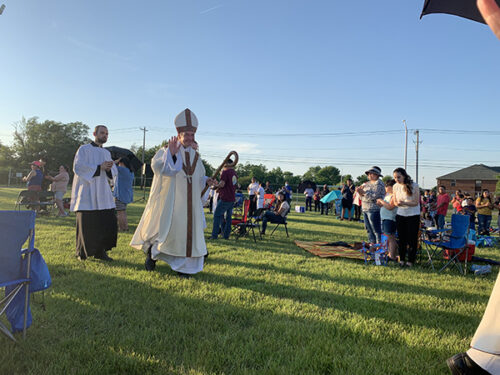
COLUMBUS, Ohio — When Saul Buitron reflects on Bishop Robert Brennan’s impact on the Hispanic Catholic community in the Diocese of Columbus, the phrase that comes to mind is “it’s been a dream come true.”
Bishop Brennan has prioritized the Hispanic Catholic community since the day he arrived in the Diocese of Columbus. Almost immediately, he created its first office of the Vicar for Hispanic Ministry. Buitron, who is the Hispanic Ministry coordinator at Christ the King Catholic Church in Columbus, and other leaders say the new office had the domino effect of bringing the community together and allowing it to blossom.
“The bishop is constantly trying to bring [Hispanic Catholics] to the forefront,” said Father David Schalk, the diocesan vicar for Hispanic ministry. “So what’s the fruit of that? It’s a whole lot easier to organize events, to name key lay leaders, and to convince Hispanics they’re not just the future of the Church but they are the Church right now.”
The Hispanic population in the 23 counties that make up the Diocese of Columbus has steadily increased over the last decade — just short of a 50% increase — totaling 102,699, or 3.7% of the population, in 2019.
Although it’s growing, the number is far less than the Hispanic population in the Diocese of Brooklyn, which is known as the “Diocese of Immigrants.”
The Hispanic population in Brooklyn and Queens — the two counties that make up the Diocese of Brooklyn — totals 493,232 and 641,496 respectively or 23% of the population.
For Bishop Brennan, his passion for the Hispanic Catholic community goes back to his time at St. Agnes Cathedral in the Diocese of Rockville Centre. He said he fell in love with its Hispanic community, and that inspired him to learn Spanish.
“To me the Hispanic Catholic community is young, it’s very family-centered, it’s devotional, and there’s tremendous amounts of faith,” Bishop Brennan said. “These are real people carrying real burdens of everyday life, and maybe when you have to work hard to make ends meet you’re not worried about some of the sillier things, and so these are people that are really engaged.”
When Bishop Brennan arrived in Columbus in 2019, he recognized there were Hispanic Catholics in the diocese that were “sort of like a hidden group.” He wanted to bring them together “to celebrate the life of the Hispanic population here in the diocese and give them some strong leadership.”
That revelation prompted the creation of the Hispanic ministry office and the bolstering of the community’s lay leadership. Lisset Mendoza, the director of the office, noted that Bishop Brennan “really heard the voices of the Latino folks and knew more had to be done—so our office was very, very, very, busy early on.”
Father Schalk said part of those early efforts was making the diocese bilingual by translating documents and communicating to the community in Spanish. Another one of Bishop Brennan’s early goals was to develop diocesan priests to minister in Spanish; he now encourages the seminarians to learn the language, as well. During the height of the COVID-19 pandemic — and continuing to this day — the office added a Spanish Mass recording that’s played on the local Catholic radio station at 10 a.m. every Sunday.
In his two-plus years with the diocese, Bishop Brennan has also created events specific to the Hispanic community. One of the biggest is the annual Guadalupe Youth Summit aimed at helping Hispanic youth understand their identity as Hispanic Catholics.
“He’s really shared his own experience of being the grandson of an immigrant,” Father Schalk said. “He’s opened up his heart in that way to help these young people who are children and grandchildren of immigrants embrace their Catholic identity and their role in the church and in society.”
Other events included an inaugural diocesan-wide Our Lady of Guadalupe celebration last December to “galvanize the Hispanic community,” as well as celebration of the Church’s Year of St. Joseph for the Hispanic community and a Mass on Sept. 16 to kick off Hispanic Heritage Month.
Bishop Brennan “celebrated that Mass in Spanish and spoke of the strengths and gifts of the Hispanic community and how they’re renewing the church,” Father Schalk said.
Buitron, who is also the music director at Christ the King Catholic Church, also recognizes the efforts of Bishop Brennan on a personal level. He noted that Bishop Brennan has visited all of the Spanish-speaking parishes, and one of the most important things is the way he communicates in Spanish.
When the Hispanic community “feels connected with somebody they just come together, and that’s what Bishop Brennan does. He just connects with people,” said Buitron.
Now, with his departure looming, Bishop Brennan looks back on the progress made with satisfaction.
“I find it very rewarding to see that community recognized and to see the sharing of gifts, and I think that community has something to teach the rest of the Church in terms of faith and enthusiasm for the faith,” Bishop Brennan said.
